A Trip on the Whaling Ship Charles W. Morgan | History Under Sail
What’s it like to sail on the historic 19th century Charles W. Morgan whaling ship re-launched after nearly 75 years? Yankee was there for that once-in-a-lifetime opportunity.
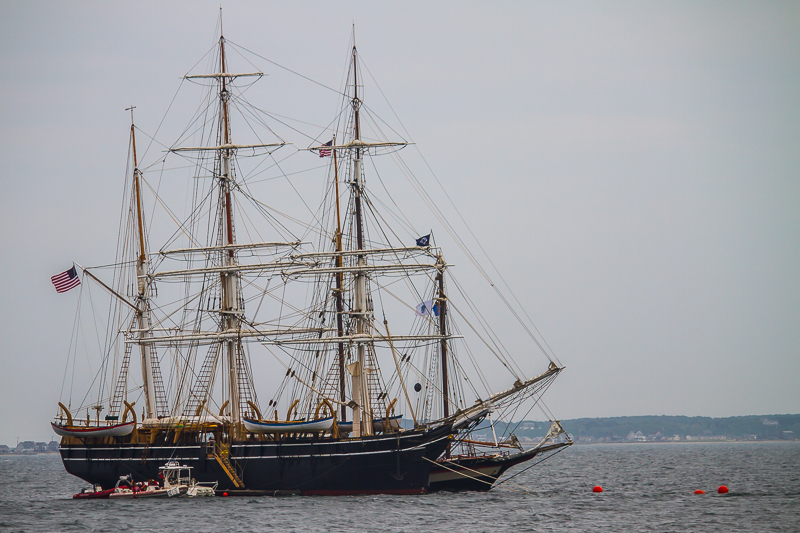
The Charles W. Morgan anchored at Provincetown. She is tethered to a support ship, the Mystic Whaler.
Photo Credit : Justin Shatwell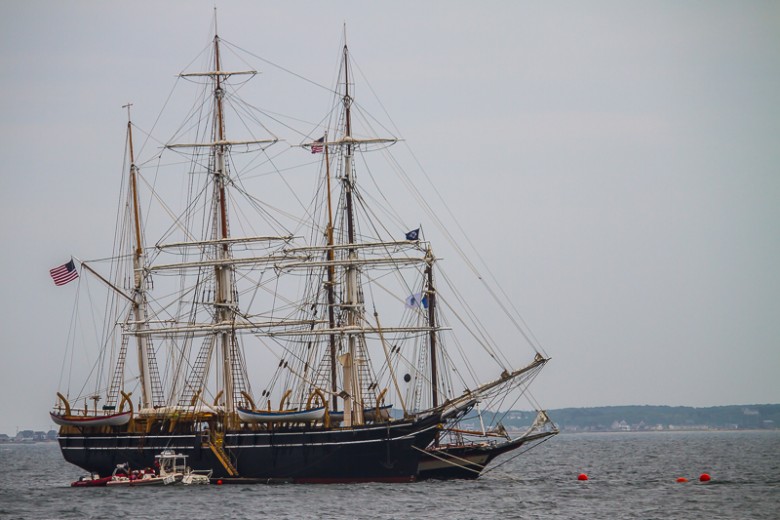
Photo Credit : Justin Shatwell
The launch left at dawn. Easing into Provincetown Harbor, the captain turned his back to the whipping flags of MacMillan Wharf and cut a quick path to the breakwater. The gaggle of reporters and dignitaries aboard craned their necks to catch a glimpse of their destination as she emerged from behind the stony wall. Couched in the early-morning gloom, the Charles W. Morgan stood at anchor, as tall and still as a Scottish castle, patiently awaiting her guests.
The call had gone out the day before that the ship would sail as planned on July 15. The clinging dampness in the air that morning was enough to confirm what the meteorologists had been warning: A front was moving in fast and would sock the Cape in with thunderstorms for days. The decision was clear: Sail now or get comfortable in Provincetown. Luckily for those of us asked to tag along on this voyage, the crew had commitments to keep in Boston.
For everyone aboard the launch, the day promised to be a memorable one. Sailing on the Morgan would be a once-in-a-lifetime opportunity, because it’s very possible that the Morgan might never sail again in our lifetimes. The fact that she was sailing at all was a miracle five years in the making.
In the spring of 2009, while the economy wallowed in the worst of the recession, the administrators of Mystic Seaport struggled to find some plan to boost the museum’s fortunes—something that would be, as museum president Stephen White put it, “different and magnificent.” Their eyes quickly turned to the restoration of the Morgan, which had already begun the previous fall. Just to keep the ship tied to her dock, as she had been for the previous 68 years, they’d have to repair or replace everything below the waterline. How much more would it take to make her seaworthy? How much more would it take to bring her back to life? Speculation quickly turned into a plan. Once she was sound, the Morgan would sail again—the 38th voyage of her storied career—on a tour of the ports of southern New England.
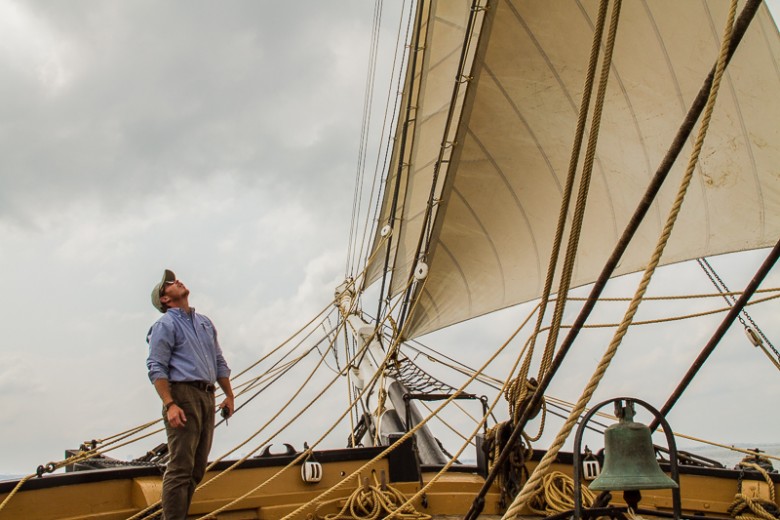
Photo Credit : Justin Shatwell
On May 17th, 2014, the Morgan began her passage, easing through the mouth of the Mystic River and tasting the open sea again for the first time since 1941. At every port of call—New London, New Bedford, Vineyard Haven—she received a hero’s welcome. Now she stood poised just outside Provincetown, ready to complete the last outward-bound leg of her journey before starting back to Mystic. The care and skill of hundreds of craftsmen, sailors, and museum staffers had seen her this far; she awaited only her passengers before making the final push, racing the storm across Cape Cod Bay and then passing triumphantly through the Harbor Islands into Boston.
As we passed the breakwater, the captain opened up the engines, and we sped over the last few hundred yards to the ship. The Morgan’s triple masts loomed over our launch, and for the first time the ship seemed truly tangible. No longer a misty dream on the horizon, she welcomed us—solid, ancient, and eager.
— — —
When the Charles W. Morgan was launched from the Jethro & Zachariah Hillman shipyard in New Bedford in 1841, she was perhaps the least romantic ship in America’s whaling fleet. While other ships were bestowed fanciful monikers, like the Meteor or the Sunbeam, the Morgan was christened after her chief investor, an aging Quaker with interests in several ships, whose only vision for the vessel was for her to make as much money for him as possible.
The Morgan was a pragmatic vessel—a business venture, pure and simple. Stretching 105 feet long and weighing 314 gross tons, she wasn’t the largest ship in the fleet or the fastest. Seeing the Morgan today, her most striking feature is her stoutness (a sailor can take 15 good paces across her deck from port to starboard). Within her ample belly, she had enough room to house 38 crew members, provisions to feed them for years if need be, and space for the thousands of barrels of whale oil that would be rendered on her deck during the voyage. She was a factory, barracks, and warehouse all rolled into one floating (and, one could presume, fetid) package.
Between the years 1841 and 1921, the Morgan had a distinguished career, making 36 voyages for various owners and hunting whales in every ocean. She was profitable, too. The flesh-and-blood Charles W. Morgan more than recouped his investment on her very first voyage. But it isn’t the fortune she made for her owners that has led to her present fame. It is, rather, the attribute most cherished by the lowly seamen who manned her: her uncanny ability to not sink.
At its peak in 1846, the American whaling fleet was 736 vessels strong, but that number quickly shrank after the Civil War. Ships were either wrecked or retired as petroleum began replacing whale oil as the country’s fuel of choice. When the Wanderer was ripped apart on the rocks of Cuttyhunk Island in 1924, the Morgan became the last surviving member of this once-august fleet. Overnight she’d gone from being a semi-retired barque to an American treasure, and people began wondering what to do with her.
The Morgan began her second life as a museum in Dartmouth, Massachusetts, where she was displayed on the private estate of Colonel E. H. R. Green from 1925 to 1936. After Green’s death (and the resulting wrangling over his will), the ship passed to the Marine Historical Association of Mystic, Connecticut, the nascent group that would become modern Mystic Seaport. Founded by old seamen and dedicated to preserving the last vestiges of the rapidly disappearing age of wooden ships, the group made the Morgan the cornerstone of their collection, and it remains so today. It’s common to hear workers at the museum refer to her as “the crown jewel.”
And so it comes as no surprise that when Stephen White announced at an all-staff meeting in 2009 his plan to sail the Morgan, the news was met with a resounding, universal gasp. “An exclamation without words,” he recalls. “Just air coming out of people’s lungs.”
The idea was radical, to say the least. So much of modern preservation involves taking artifacts out of the world. You store them in climate-controlled rooms and acid-free environments. You shelter them from salt, moisture, and direct sunlight. You lovingly rest them on softer and softer pieces of velvet under ever-thicker panes of glass. What you don’t do—what you never do—is throw them into the ocean.
— — —
Shortly into our crossing, the general morning gloom evolved into a thick and pervasive fog. The world seemed to have shrunk, and anything more than a few hundreds yards away disappeared into the churning whiteness. The Roann, a restored eastern-rig dragger that was serving as the Morgan’s support vessel, skirted behind the ship at the edge of our vision, flickering in and out of the veil. I couldn’t help but wonder how ghostly our ship must have looked from her deck.
There is nothing on earth so much like crossing the river Styx as sailing through a New England fog bank. The experience makes it easy to understand why sailors crafted so many superstitions around their work. In an age before satellite phones and Coast Guard rescue helicopters, any illusion of control would be a balm, especially at times like this. Cut off from the world with no idea of what lies ahead of you, it might be enough for a sailor to begin questioning his line of work.
If any such doubts troubled the head of Captain Richard “Kip” Files, no evidence of it emerged from behind his bristling mustache and black sunglasses. Leaning against the gunwale and gazing out into the gray, he looked completely in his element.
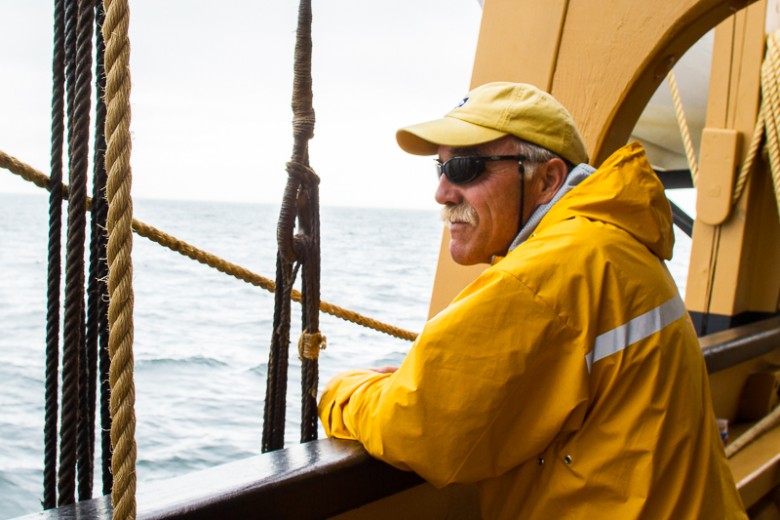
Photo Credit : Justin Shatwell
If it’s possible for anyone today to be overqualified to captain a 19th-century whaleship, Mystic Seaport might have found its man in Files. He’s spent most of the last 25 years captaining tall ships, many with similarly impressive pedigrees as the Morgan. His own ship, the windjammer Victory Chimes, is, like the Morgan, a National Historic Landmark. He doesn’t quail before the responsibility of captaining a piece of history, stomping about the deck like a man confident that he’s standing on a ship, not in a museum.
“I don’t look at it as a piece of china on a display table,” he said between blasts from the foghorn. “She’s strong enough to do what we’re doing.”
That strength was never taken for granted. When the idea to sail the Morgan was first floated in 2009, Mystic Seaport organized a committee to study the proposal and, effectively, to talk the museum out of it. “Prove to me that this isn’t the best thing to do,” is how Stephen White recalled their mission.
But after talking to conservators, scholars, and insurance agents, they conceded that it was feasible. The museum had to repair the Morgan’shull one way or another, and everyone agreed that once that was complete, she’d be as strong as she’d ever been at any point in her career. That covered the “could”—but what about the “should”?
Museums are charged with preserving their artifacts above all else. Although the Morgan had proved resilient during her 80-year career—she’d run aground several times, been struck by lightning, weathered two hurricanes, and was briefly set ablaze—any voyage, even with all our modern safety devices, would carry some risk. And unlike other historic vessels that continue operating, the Morgan is the last of her kind. If she encountered some disaster along the way, Mystic Seaport would forever be known as the museum that sank the last American whaleship. That would satisfy White’s desire to do something “different,” but fall distinctly short of “magnificent.”
There were valid reasons to take on the risk, though. Mystic Seaport, which consists of dozens of buildings arranged to resemble a historic shipping district, has always believed in the value of cultivating a “sense of place” as part of its interpretation plan. In what place would a ship like the Morgan be best understood—at port or sailing the open ocean? Stephen White argued that the ship was most relevant at sea and that seeing her there would be an intrinsically more powerful experience, akin to viewing the Mona Lisa in the studio where it was painted.
Ultimately the decision came down to a discussion of the ship’s “soul.” Susan Funk, an executive vice-president at the museum, recalled that the Morgan’s curators came to believe that the true essence of some artifacts couldn’t be understood unless they were used. “A violin sitting on a shelf helps you appreciate the craftsmanship that went into making it,” she said, “but it misses the liveliness and the soul of the instrument, which really emerges only when it’s played. And we felt the same was true of the Morgan. A ship is made to move.”
From the deck of the Morgan, Files echoed that same philosophy in a gruffer, more matter-of-fact kind of way. As a sailor, the benefit of sailing the ship was obvious. “It was never designed to be a static symbol at the dock—that wasn’t her function,” he said. “You can’t read about [sailing the Morgan] and expect to learn anything about it. You have to do it.”

Photo Credit : Justin Shatwell
Unfortunately, in the depths of the fog there was very little sailing to be done. As a precaution, it had been decided to tow the Morgan across Cape Cod Bay until the weather improved. The crew had set half her sails in Provincetown, but that was mostly for show. Now there was little for them to do but swap stories and take their turns at the helm, where they’d lazily fix the wheel to mirror the course of the tug ahead, barely visible in the mist.
White had warned that there would be moments like this. The museum had instituted strict guidelines for sailing the ship through inclement weather, and he acknowledged that it might cause some grumblings from the passengers and crew. “It’s like saying, ‘We know you can ride a bicycle, but we’re still going to keep the training wheels on in case you lose your balance.’ ”
As the Morgan neared the trunk of Cape Cod, however, whispers flitted about the ship that we might be let off our leash. The sun had cut through the fog like a ray of hope, and Plymouth’s gray shore could be discerned in the distance. As we turned north, Second Mate Sean Bercaw offered encouraging insight into the captain’s plan. “I think he wants to wait until we’re a little bit closer,” he said. Just a little bit closer.
As Boston Light’s welcoming blink peeked over the horizon, we were still in tow. Curious pleasure boats came out to meet us and fell in line around the ship. In another hour our colorful flotilla was thick among the outer harbor islands. The fort on Castle Island was just coming into focus off the bow when finally the order came to break free. The captain wouldn’t be towed into port without doing at least one victory lap around the harbor, a ponderous pirouette to show the motorboats around us what it meant to truly sail.
At once the crew was on their toes, racing fore to aft and back again. A mate would call out a command, “Fore upper topsail avast!” and hear it immediately echoed by the crew. “Slack out of starboard,” he’d yell. “Slack out of starboard,” came back. All across the ship, ropes were pulled or loosened and tied down, until they reached the perfect combination for the ship to respond. Above, the entire sail structure shifted from port to starboard in one mighty tack—and all of a sudden Castle Island was behind us.
It’s a common cliché for writers to comment on the billowing of the sails and the creaking of the hold, but the Morgan offered no such soundtrack as she swept through the water. With the drone of the tug’s engine finally gone, it became clear just how silent the Morgan was. The ship was tight. Her joints offered not a whisper of complaint, and her sails didn’t so much as shiver. They filled with wind and were still—somehow static and dynamic at the same moment as they pushed the ship ever forward.
After that first tack, an eerie moment fell over the ship. The sails were set, and the crew’s call-and-response hymn took an extended rest. All we could hear was the breaking of water across the bow, like the babbling of a distant stream. This was the moment we’d been waiting for. The wind and sails and ship and waves had finally aligned, and the Morgan was truly sailing, cutting an effortless line through the swells of the outer harbor, perfectly in tune.
And then it was over.
The mates ordered the crew through a second tack, and Boston swung back in front of our bow. The tug reappeared off the port side, and ropes were passed over to secure the Morgan to her hull. We motored over the final distance through the reflected grandeur of the city above and arrived at last at Charlestown Navy Yard. Soon the Morgan would begin her journey home, where she’d be relieved of her ballast and resume her second career as a museum exhibit.
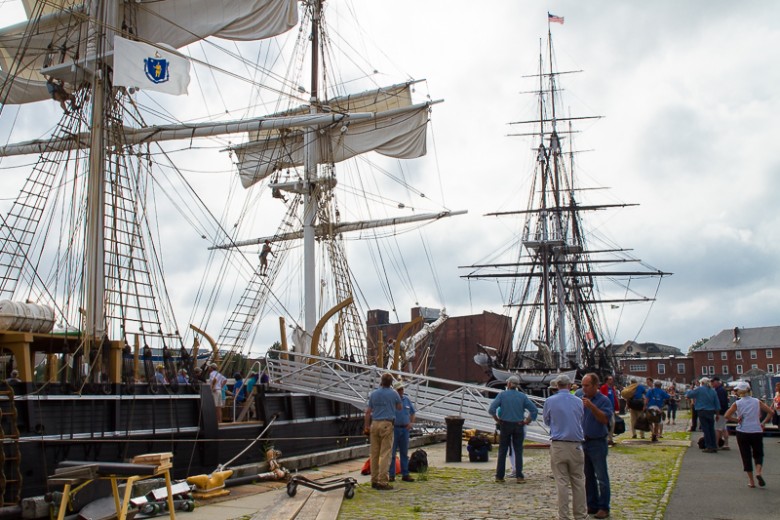
Photo Credit : Justin Shatwell
Was it worth it? Will the Morgan’s 38th voyage translate into ticket sales at Mystic Seaport? There were no accountants on board to calculate the PR value of our entrance into Boston, and there’s no way to know whether, 30 or 40 years from now when the Morgan needs another overhaul, the children who witnessed her sail this day will reach wistfully for their checkbooks. Like all historical exercises, the return on investment is impossible to quantify, existing almost solely in the eye of the beholder.
But what can’t be contested is that this sail completed its mission: It was, undeniably, magnificent. And while I can’t say for sure whether or not I witnessed the Morgan’ssoul returning in those few moments when the ship sailed free and the ocean, crew, and ship worked as one, I can’t deny that something took my breath away.
Justin Shatwell
Justin Shatwell is a longtime contributor to Yankee Magazine whose work explores the unique history, culture, and art that sets New England apart from the rest of the world. His article, The Memory Keeper (March/April 2011 issue), was named a finalist for profile of the year by the City and Regional Magazine Association.
More by Justin Shatwell

